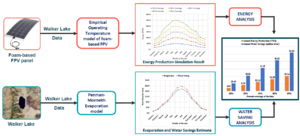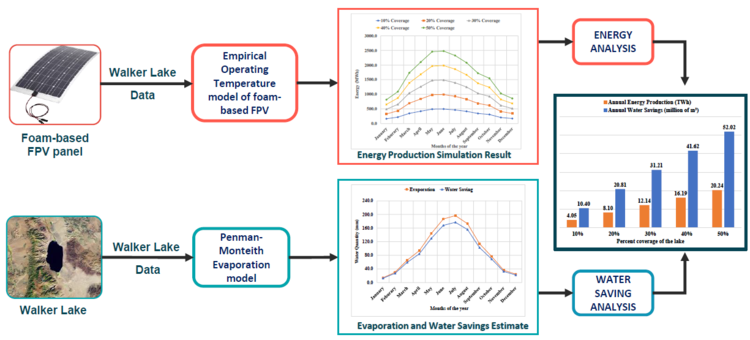
Terminal lakes are disappearing worldwide because of direct and indirect human activities. Floating photovoltaics (FPV) are a synergistic system with increased energy output because of water cooling, while the FPV reduces water evaporation. This study explores how low-cost foam-based floatovoltaic systems can mitigate the disappearance of natural lakes. A case study is performed on 10%–50% FPV coverage of terminal and disappearing Walker Lake. Water conservation is investigated with a modified Penman-Monteith evapotranspiration method and energy generation is calculated with an operating temperature model experimentally determined from foam-based FPV. Results show FPV saves 52,000,000 m3/year of water and US$6,000,000 at 50% FPV coverage. The FPV generates 20 TWh/year of renewable energy, which is enough to offset all coal-fired power plants in Nevada thus reducing carbon-emission based climate forcing partially responsible for a greater rate of disappearance of the lake. The results of this study, which is the first of its kind, indicate foam-based FPV has potential to play a crucial role in mitigation efforts to prevent the disappearing of natural lakes worldwide.
- For Calculations see: Project Page on OSF
- For designs see: Distributed manufacturing of after market flexible floating photovoltaic modules
- For a literature review on FPV see: Solar floatovoltaics lit review
Graphical Abstract[edit | edit source]
Keywords[edit | edit source]
Floating photovoltaic; FPV; Flexible; Sustainable development; Open-source; Photovoltaic; Racking; water; energy water nexus; dual use; water conservation; FPV; solar energy; Floatovoltaic; Water conservation; Solar energy; Terminal lakes
See also[edit | edit source]
- Distributed manufacturing of after market flexible floating photovoltaic modules
- 3-D Printing Solar Photovoltaic Racking in Developing World
- Water Conservation Potential of Self-Funded Foam-Based Flexible Surface-Mounted Floatovoltaics
- The Greenest Solar Power? Life Cycle Assessment of Foam-Based Flexible Floatovoltaics
- Impacts of Location on Designs and Economics of DIY Low-Cost Fixed-Tilt Open Source Wood Solar Photovoltaic Racking






